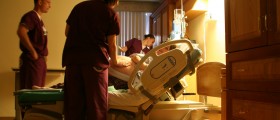
Down Syndrome – Genetic Condition
Down syndrome is a genetically inherited disorder which affects 1 in 800 live births in America every year. Down syndrome is the most common genetic condition present right at birth. The exact causes of the disorder are unknown but it is clear that the affected individuals inherit additional genetic material at conception. Instead of inheriting 23 chromosomes from the mother and 23 from the father, one whole additional chromosome 21 is passed down to the embryo. In some milder forms of the syndrome only parts of the additional chromosome 21 are inherited. The extra genetic material is responsible for physical and mental developmental delays. It is, however, very difficult to estimate the extent of the condition right at birth. Some Down syndrome patients live relatively healthy lives while others require long term medical care. In addition, children with the condition learn at different pace and reach developmental milestones later than the general population. With proper care and early intervention programs which include physical, occupational, and speech therapy the child will reach his or her full potential and live as fulfilling a life as possible. Mild to moderate cognitive impairment is observed as well but many learn to take care of themselves and lead relatively independent lives. When it comes to the physical symptoms of Down syndrome, individuals are characterized by short torsos and limbs, flat facial profiles, small ears, long tongues and small mouth. The disorder is usually accompanied by an array of medical problems. In many cases persons are affected by respiratory, gastrointestinal, and heart defects. Heart problems have to be diagnosed right at birth and surgery may be required to remove the anomalies. Long term medication is often necessary to maintain proper functioning of the heart. Many Down syndrome patients are also susceptible to infections and more often than not have low muscle tone. Hearing and vision problems are also commonly detected.
Birth Complications with Down Syndrome
Although the exact causes are unknown risk factors for Down syndrome have been identified. There is a strong correlation between the age of the mother and the presence of Down syndrome. Women over the age of 35 have a much greater chance of having a developmentally challenged child than their younger counterparts. The risk keeps on increasing with age. As the condition is so common, regular screening for Down syndrome is available for couples. The screening is primarily performed to give the prospective parents the opportunity to decide whether to keep or terminate the pregnancy or to prepare for raising a child with special needs. The screening is therefore administered during the first trimester of the pregnancy. Blood tests are often enough to point to the presence of certain hormones and proteins that reveal the condition. The initial screening has been proven 87 percent effective. Those who follow up in the second trimester receive results that are 95 percent accurate. It should be noted that screening is not done for diagnostic purposes but to assess the chance that the child has for having inherited additional genetic material.
Medical Conditions Associated with Down Syndrome
The most prevalent medical problems that follow Down syndrome are heart anomalies. Almost half of the diagnosed individuals have congenital heart problems. The most widespread heart condition is the septal defect, which is present in 9 out 10 cases. The septal defect is characterized by a hole in the wall that separates the chambers of the heart. The condition results in blood build up in one of the chambers, which puts a strain on the organ. Those with only minor problems require minor procedures, while the more severe cases go through open heart surgery to fix the anomaly. Another very common health concern is the loss of hearing. Almost 50 percent of Down syndrome individuals have issues with the middle ear. Excess fluid builds up and distorts the ability to hear. As a result the child will have difficulties learning to speak as the sounds are muffled and deformed. Surgery or hearing aids are the primary form of treatment coupled with regular sessions with a speech therapist. In addition, Down syndrome individuals often suffer from vision problems. They are short sighted, long sighted, or have a condition called lazy eye where one of the eyes does not develop properly and does not possess strong focusing ability. Other common eye problems are cataracts and proneness to eye infections. Many patients also suffer from tooth decay and poor oral health. The teeth are progressively broken down by bacteria or the gums are severely infected. Down syndrome individuals often have weak motor skills preventing them from being able to brush their teeth properly. Also, their levels of saliva are lower, making the gums and teeth more prone to bacterial infections. High fluoride toothpaste is often recommended for prevention. Electric tooth brushes might be easier than the manual ones, and some persons need help with brushing their teeth.

















Your thoughts on this
Loading...